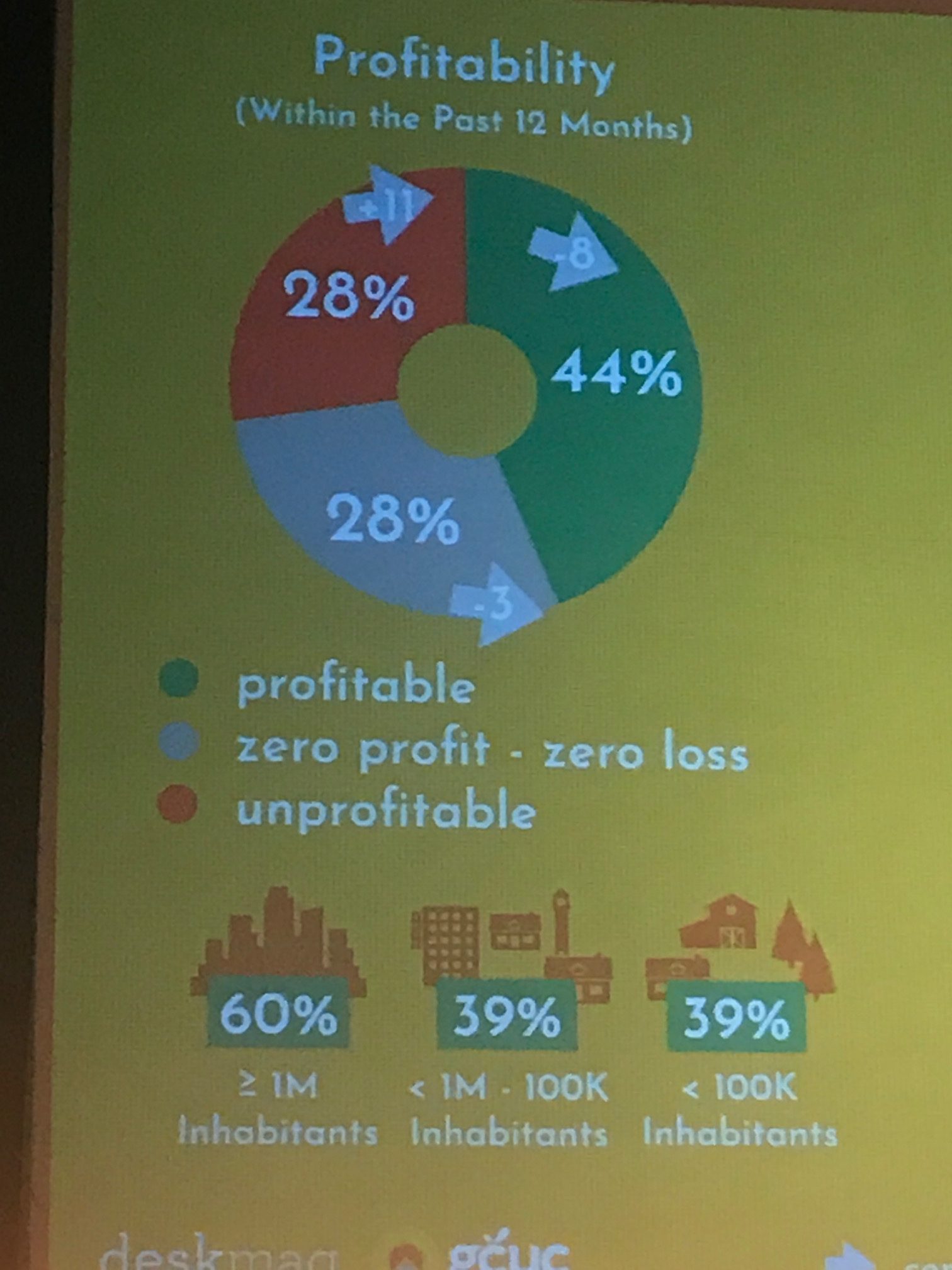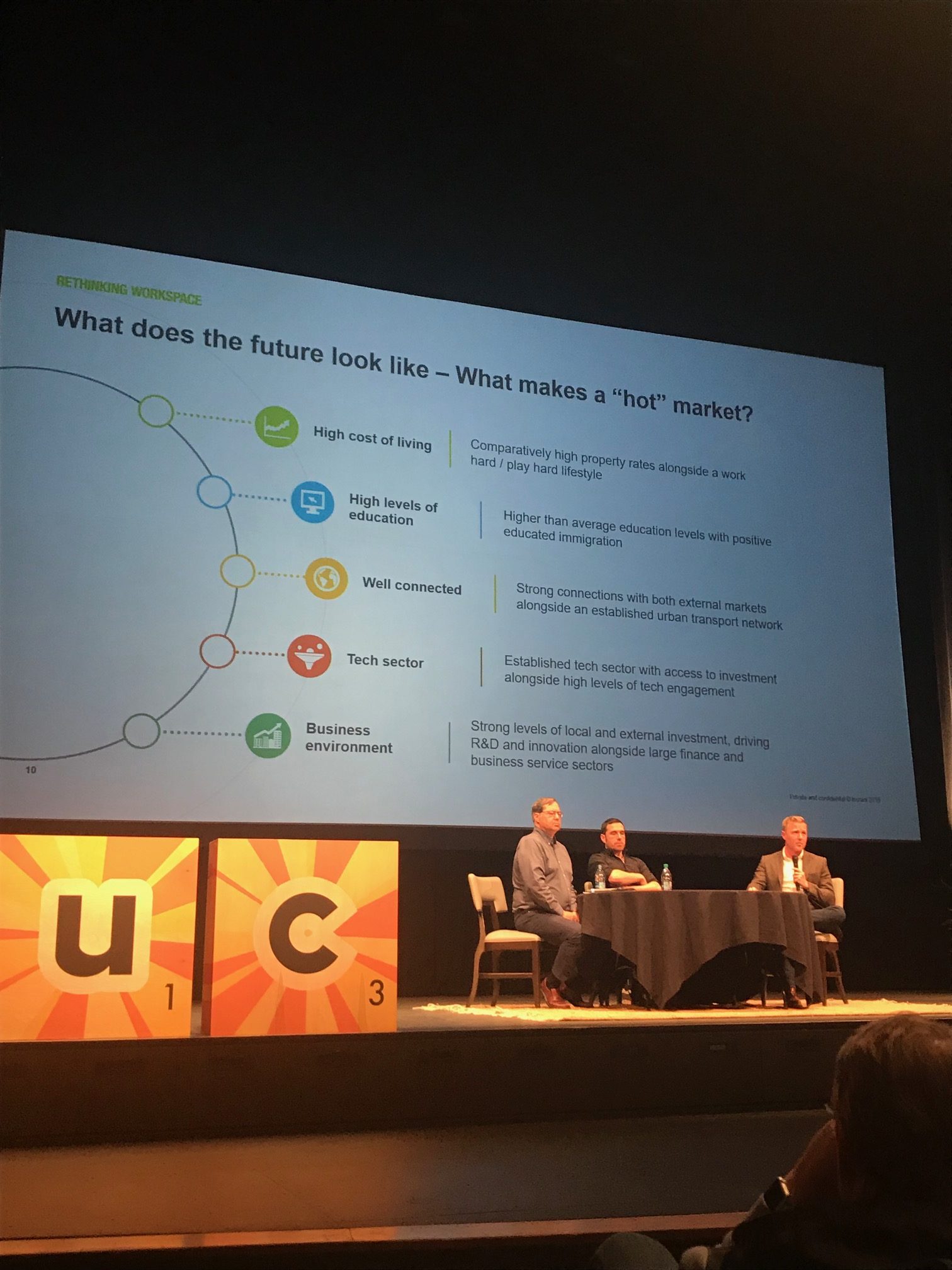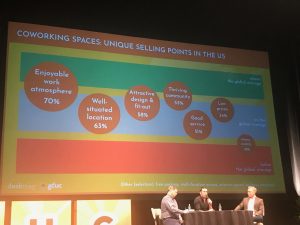After Camp GCUC on day 1 of the event, Tuesday brought about the biggest crowds and more diverse panel discussions at GCUC 2019. We even got to sit inside the opera house theater for the sessions, about as unique and glamorous a venue as anyone could have envisioned.
Let’s run down the list of discussions and key takeaways:
Wellness
Philip Vanhoutte, founder of Ozadi, led a session on the five keys to wellness and the importance of nature in the work environment.
He named noise as the main issue that employees have to overcome in a workspace. Acoustic shielding is more important than ever to absorb, block and/or cover excessive noise.
There are those who believe one of the core components of coworking – open style work space – is poor due to interruptions and noise. But human-centered design is vital to successful work. We need interaction without the overwhelming interruptions. Philip explained that its not ‘natural’ to be sitting indoors, with no view, staring at a screen with low air quality most of the day. The outcome is more stress and illness than we’ve seen in the past. Incorporating nature into your day will greatly increase your health and well being.
Women in Coworking
This was a fantastic discussion led by four of the most prominent women in the industry: Ashley Proctor , Angel Kwiatkowski, Amy Nelson, and Iris Kavanaugh.
Here’s an incredible stat they shared: Only 1% of startups get access to venture capital funding, and of that 1%, only 4% goes to women. These four ladies are working toward making that number skyrocket to where it needs to be. Only 1 out of every $23 in small business loans goes to a woman.
Ashley mentioned how she received public funding, grants, and basically any other source of income she could, when funding 312 Main in Vancouver. But before she did any of that, she ran an education campaign at the federal level. She needed to make them understand the incredible value an importance her vision would bring to the city, especially in a difficult/underserved neighborhood to live in.
However, as groundbreaking and phenomenal as that is, Angel explained she actually did not fundraise at all in her 10 years of success as an operator, proving it is possible to start from your own savings and grow from there.
The surge in all-women’s spaces has not only helped open the eyes of our industry to women’s specific needs, but also to the plague of negative conduct and harassment toward women in the workplace. It’s vital to train and educate staff and members on how to handle issues of this kind. You can and should make members sign an agreement (don’t have to call it a code of conduct) which states they understand and will abide by rules in the office respecting women.
The rise of these spaces stems from the ability to be yourself. Women share ideas, thoughts, actions that don’t commonly fit in with a male-dominated industry.
Research Roundtable
As a stats and numbers ‘nerd’, I thoroughly enjoyed this session. Deskmag founder Carsten Foertsch provided insight into the results of this year’s Global Coworking Survey, which is an annual barometer into the state of the industry.
A few of the most notable stats he revealed: average member size per location is up to 99, a significant jump from one year ago. Profitable spaces totaled 44% of the results, a number surprisingly down eight points from last year. However, that profitable number jumps all the way to 60% in large cities (1M+ inhabitants). Check out the screenshots for more in-depth data.
Design to Differentiate
Jacob Bates, CEO of CommonGrounds, led this session on how to make your space stand out in a crowded market. His first point was to establish that he does not feel the market is saturated, as some may say.
Make your space feel large and open, but still find a way to incorporate as much seating as possible. One key differentiator in design is the level of control occupants have, from thermal conditions, to lighting, movable desks, HVAC, and many other customizable factors.
Furniture, acoustics, mountable walls, natural daylight all play a role in wellness in your workspace. Use big data for adjustments. If data says people use this space more, or a certain area generated no revenue, change up your strategy!
Succession Planning
Of course we’d all like to think we’re in this industry for the long haul, but what about your exit strategy? How do you value what you’re selling? What’s the process behind an acquisition? These were all questions that a great panel, led by Nicole Vasquez and Rebecca Brian Pan, attempted to answer for the crowd.
Keep in mind you don’t necessarily have to sell your brand. You can sell based off members’ experience, the fact the buyer wouldn’t be starting from scratch with an already built-in community, and an established member base. Start small and work your way up. Value each member but also sell based off projected revenue for the coming year.
It’s hard to say there will be a specific valuation formula because its not as straightforward as the private office industry. But its a process you will not be going through alone. Hire financial experts, and others who will surround you to create the best exit strategy possible.
DAY 3
Unconference
Everyone loves the uniqueness and inclusiveness of the unconference day. Attendees get to nominate topics they want to hear discussed at length, and the topics with the most votes get their own break out session. The two I got to attend were incredibly detailed and insightful.
Marketing
Not that I had any vested interest in this session… of course not.
So where are your marketing dollars spent? SEO will be and should be a big portion of this budget. Your website needs to be easily accessible and highly visible on google searches. PPC campaigns are the best bang for your buck when it comes to visibility. Instant Offices spent $2.5M on PPC in the last year. Their scope is far larger than most, but you get the idea.
Content marketing is key. Feature your members consistently on your social platforms and blogs.
Creating landing pages for your contact forms is very important. Don’t just direct people to the contact us page. Create dedicated pages that are relevant to the ad the person clicked on.
Social media and paid social ads are extremely important to grow your reach well beyond your local area. If your space is visually beautiful or unique in any way, use Instagram to your benefit to showcase it.
One operator explained that nearly 50% of her leads came directly from people who drove or walked by the front of her space. Yes, you may get 50% of your leads online, but it’s vital to spend time and dollars improving the street facing signage and branding, especially if you’re in a highly populated area.
Financing / Profitability
The most important thing you have to understand about financing, is that you have to maximize your ‘monetizable’ space. Ideally you want close to 80% of your space to be some sort of a moneymaker for you.
Know your demographics. Are you serving attorneys, freelancers, or any other single employees? Are you serving teams or small businesses? The amount of tables, office space, meeting rooms, and other areas depend on the answers to these questions. A potential split of 40% office suites, 20% dedicated desks, and 40% open desks could work well.
There is no set in stone method for profiting in this industry. One way that can work for just about any operator is a virtual mailing address. Providing a mailing service, for maybe $65 a month, is a simple way of getting hundreds of new members. And you don’t need any additional space!
Tip: Don’t give any free hours in meeting rooms. They’re too profitable to be relegated to giveaway hours. Simply give members a discount, but open the meeting rooms to anyone who wants to book them. One operator with 36K sq ft of space said he nets about $30K a month in meeting room revenue, providing rooms as small as one table for 4 people, to classroom-style room with space for 50+.
Also remember, after 5 or 6pm your hotdesk area can become event space. Use it on weekends as well! Book any sort of event you can find. Even if your average member is paying $260/month for a desk, you can still be profitable due to overbooking, events, meeting rooms, and virtual mailing address service.
Finally, try to resist the long term commitment model. Even 3-6 month plans may not be your best bet. More people are willing to try on a month at a time than long term right off the bat.
Whew! That does it for GCUC 2019 in Denver! It was a blast, we met tons of incredible people and reconnected with others. Can’t wait for the next one!



